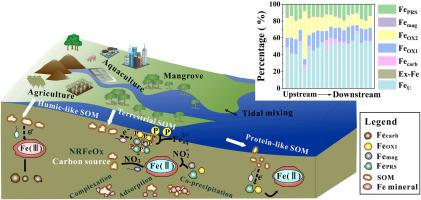海岸带SOM降解调节红树林沉积物中铁的转化及其环境意义
IF 3.4
3区 地球科学
Q1 GEOCHEMISTRY & GEOPHYSICS
引用次数: 0
摘要
铁(Fe)是一种关键的微量营养素,在管理红树林生态系统的健康和服务方面发挥着至关重要的作用。然而,沉积有机质(SOM)对红树林湿地铁元素迁移转化的影响尚不清楚。利用序列提取法和光谱技术,研究了海南岛东寨港红树林表层沉积物中铁的生物地球化学过程和SOM组分对铁行为的影响。结果表明:红树林沉积物中的铁主要为无定形氧化物(FeOX1)、结晶态氧化物(FeOX2)和硅酸亚铁(FePRS)。EEM-PARAFAC模型成功地鉴定了四种荧光成分:三种腐殖质样成分(C1、C2和C3)和一种蛋白质样成分(C4)。陆生腐殖质具有通过吸附、络合和共沉淀固定FeOX1、FeOX2、磁铁矿和FePRS的潜力。微生物降解的腐殖质样物质可能在微生物存在的情况下促进铁的转化,同时参与氮和磷的循环。这一过程可能导致上覆水体的营养水平增加和富营养化。这些发现有助于深入了解红树林沉积物中Fe-SOM耦合的生物地球化学循环过程,为红树林湿地的生态保护提供有价值的指导。本文章由计算机程序翻译,如有差异,请以英文原文为准。

Coastal SOM degradation regulates the transformation of iron in mangrove sediments and its environmental significance
Iron (Fe), a key micronutrient, plays a vital role in governing the health and services of mangrove ecosystems. However, the migration and transformation of Fe induced by sedimentary organic matter (SOM) in mangrove wetlands remains unclear. Here, we investigated the Fe biogeochemical processes and effects of SOM components on Fe behaviors in mangrove surface sediments from Dongzhai Harbor, Hainan Island, using sequential extractions of Fe species and spectroscopic techniques. The results showed that most of the Fe species were amorphous oxides (FeOX1), crystalline (FeOX2), and ferrosilicate (FePRS) in mangrove sediments. The EEM-PARAFAC model successfully identified four fluorescent components: three humic-like components (C1, C2, and C3) and one protein-like component (C4). Terrestrial humic substances have the potential to immobilize FeOX1, FeOX2, magnetite, and FePRS through adsorption, complexation, and co-precipitation. Microbial degraded humic-like materials may facilitate Fe transformation in the presence of microorganisms while concurrently engaging in the cycling of nitrogen and phosphorus. The processes potentially lead to increased nutrient levels in the overlying water and eutrophication. These findings offer insights into the Fe-SOM couple biogeochemical cycling processes in mangrove sediments, further providing valuable guidance for the ecological conservation of mangrove wetlands.
求助全文
通过发布文献求助,成功后即可免费获取论文全文。
去求助
来源期刊

Applied Geochemistry
地学-地球化学与地球物理
CiteScore
6.10
自引率
8.80%
发文量
272
审稿时长
65 days
期刊介绍:
Applied Geochemistry is an international journal devoted to publication of original research papers, rapid research communications and selected review papers in geochemistry and urban geochemistry which have some practical application to an aspect of human endeavour, such as the preservation of the environment, health, waste disposal and the search for resources. Papers on applications of inorganic, organic and isotope geochemistry and geochemical processes are therefore welcome provided they meet the main criterion. Spatial and temporal monitoring case studies are only of interest to our international readership if they present new ideas of broad application.
Topics covered include: (1) Environmental geochemistry (including natural and anthropogenic aspects, and protection and remediation strategies); (2) Hydrogeochemistry (surface and groundwater); (3) Medical (urban) geochemistry; (4) The search for energy resources (in particular unconventional oil and gas or emerging metal resources); (5) Energy exploitation (in particular geothermal energy and CCS); (6) Upgrading of energy and mineral resources where there is a direct geochemical application; and (7) Waste disposal, including nuclear waste disposal.
 求助内容:
求助内容: 应助结果提醒方式:
应助结果提醒方式:


